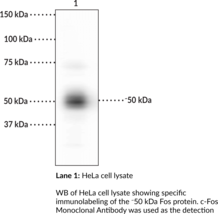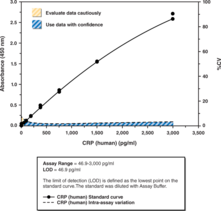Cayman
Showing 12901–13050 of 45550 results
-
BX-517 is an inhibitor of the serine/threonine kinase 3-phosphoinositide-dependent protein kinase 1 (PDK1; IC50 = 6 nM).{46560} It binds to the ATP binding pocket of PDK1, inhibits Akt2 activation induced by PDK1 in a cell-free assay (IC50 = 20 nM), and inhibits Akt phosphorylation in PC3 cells.{46561}
Brand:CaymanSKU:29238 - 5 mgAvailable on backorder
BX-517 is an inhibitor of the serine/threonine kinase 3-phosphoinositide-dependent protein kinase 1 (PDK1; IC50 = 6 nM).{46560} It binds to the ATP binding pocket of PDK1, inhibits Akt2 activation induced by PDK1 in a cell-free assay (IC50 = 20 nM), and inhibits Akt phosphorylation in PC3 cells.{46561}
Brand:CaymanSKU:29238 - 50 mgAvailable on backorder
3-Phosphoinositide-dependent protein kinase 1 (PDK1) is a serine-threonine kinase that phosphorylates and activates a range of other kinases, including PKB, PKA, and certain isoforms of PKC.{24210} BX-795 is a potent, ATP-competitive inhibitor of PDK1 in vitro (IC50 = 11 nM) and in cells (IC50 = 300 nM).{24213} At comparable concentrations, BX-795 also inhibits ERK8, MAPK-interacting kinase 2, Aurora B, Aurora C, MAP/microtubule affinity-regulating kinases 1-4, TNF receptor associated factor-associated NF-κB activator-binding kinase 1, IκB kinase ε, and additional kinases.{17331,24247,24248}
Brand:CaymanSKU:-3-Phosphoinositide-dependent protein kinase 1 (PDK1) is a serine-threonine kinase that phosphorylates and activates a range of other kinases, including PKB, PKA, and certain isoforms of PKC.{24210} BX-795 is a potent, ATP-competitive inhibitor of PDK1 in vitro (IC50 = 11 nM) and in cells (IC50 = 300 nM).{24213} At comparable concentrations, BX-795 also inhibits ERK8, MAPK-interacting kinase 2, Aurora B, Aurora C, MAP/microtubule affinity-regulating kinases 1-4, TNF receptor associated factor-associated NF-κB activator-binding kinase 1, IκB kinase ε, and additional kinases.{17331,24247,24248}
Brand:CaymanSKU:-3-Phosphoinositide-dependent protein kinase 1 (PDK1) is a serine-threonine kinase that phosphorylates and activates a range of other kinases, including PKB, PKA, and certain isoforms of PKC.{24210} BX-795 is a potent, ATP-competitive inhibitor of PDK1 in vitro (IC50 = 11 nM) and in cells (IC50 = 300 nM).{24213} At comparable concentrations, BX-795 also inhibits ERK8, MAPK-interacting kinase 2, Aurora B, Aurora C, MAP/microtubule affinity-regulating kinases 1-4, TNF receptor associated factor-associated NF-κB activator-binding kinase 1, IκB kinase ε, and additional kinases.{17331,24247,24248}
Brand:CaymanSKU:-3-Phosphoinositide-dependent protein kinase 1 (PDK1) is a serine-threonine kinase that phosphorylates and activates a range of other kinases, including PKB, PKA, and certain isoforms of PKC.{24210} BX-795 is a potent, ATP-competitive inhibitor of PDK1 in vitro (IC50 = 11 nM) and in cells (IC50 = 300 nM).{24213} At comparable concentrations, BX-795 also inhibits ERK8, MAPK-interacting kinase 2, Aurora B, Aurora C, MAP/microtubule affinity-regulating kinases 1-4, TNF receptor associated factor-associated NF-κB activator-binding kinase 1, IκB kinase ε, and additional kinases.{17331,24247,24248}
Brand:CaymanSKU:-3-Phosphoinositide-dependent protein kinase 1 (PDK1) is a serine-threonine kinase that phosphorylates and activates a range of other kinases, including protein kinase (PK)B, PKA, and certain isoforms of PKC.{24210} BX-912 is a potent, ATP-competitive inhibitor of PDK1 (IC50 = 26 nM).{24213} It less effectively inhibits a panel of related serine-threonine kinases.{24213} BX-912 has been used to evaluate the role of PDK1 in kinase activation and cell survival.{23909,24212,24211}
Brand:CaymanSKU:-3-Phosphoinositide-dependent protein kinase 1 (PDK1) is a serine-threonine kinase that phosphorylates and activates a range of other kinases, including protein kinase (PK)B, PKA, and certain isoforms of PKC.{24210} BX-912 is a potent, ATP-competitive inhibitor of PDK1 (IC50 = 26 nM).{24213} It less effectively inhibits a panel of related serine-threonine kinases.{24213} BX-912 has been used to evaluate the role of PDK1 in kinase activation and cell survival.{23909,24212,24211}
Brand:CaymanSKU:-3-Phosphoinositide-dependent protein kinase 1 (PDK1) is a serine-threonine kinase that phosphorylates and activates a range of other kinases, including protein kinase (PK)B, PKA, and certain isoforms of PKC.{24210} BX-912 is a potent, ATP-competitive inhibitor of PDK1 (IC50 = 26 nM).{24213} It less effectively inhibits a panel of related serine-threonine kinases.{24213} BX-912 has been used to evaluate the role of PDK1 in kinase activation and cell survival.{23909,24212,24211}
Brand:CaymanSKU:-3-Phosphoinositide-dependent protein kinase 1 (PDK1) is a serine-threonine kinase that phosphorylates and activates a range of other kinases, including protein kinase (PK)B, PKA, and certain isoforms of PKC.{24210} BX-912 is a potent, ATP-competitive inhibitor of PDK1 (IC50 = 26 nM).{24213} It less effectively inhibits a panel of related serine-threonine kinases.{24213} BX-912 has been used to evaluate the role of PDK1 in kinase activation and cell survival.{23909,24212,24211}
Brand:CaymanSKU:-BXL-628 is an analog of vitamin D3 (Item No. 11792) that has diverse biological activities.{40147,40148,40149} It increases death of androgen-stimulated human benign prostatic hyperplasia (BPH) cells via induction of apoptosis in a dose-dependent manner.{40147} In vivo, BXL-628 completely inhibits androgen-stimulated prostate overgrowth in a rat model of BPH. It reduces expression of IL-13 and IgE/mast cell-derived protease 1 (MMCP1) and decreases edema and leukocyte infiltration in the bladder wall in a mouse model of allergen-induced interstitial cystitis.{40148} BXL-628 also reduces the number of adherent endometrial stromal cells and decreases the total weight of endometrial lesions in a mouse model of endometriosis.{40149} Formulations containing BXL-628 are under clinical investigation for the treatment of BPH.
Brand:CaymanSKU:23129 - 1 mgAvailable on backorder
BXL-628 is an analog of vitamin D3 (Item No. 11792) that has diverse biological activities.{40147,40148,40149} It increases death of androgen-stimulated human benign prostatic hyperplasia (BPH) cells via induction of apoptosis in a dose-dependent manner.{40147} In vivo, BXL-628 completely inhibits androgen-stimulated prostate overgrowth in a rat model of BPH. It reduces expression of IL-13 and IgE/mast cell-derived protease 1 (MMCP1) and decreases edema and leukocyte infiltration in the bladder wall in a mouse model of allergen-induced interstitial cystitis.{40148} BXL-628 also reduces the number of adherent endometrial stromal cells and decreases the total weight of endometrial lesions in a mouse model of endometriosis.{40149} Formulations containing BXL-628 are under clinical investigation for the treatment of BPH.
Brand:CaymanSKU:23129 - 5 mgAvailable on backorder
BYK 191023 is an L-arginine competitive and selective inhibitor of inducible nitric oxide synthase (iNOS) with IC50 values of 0.086, 17, and 162 μM for human recombinant iNOS, nNOS, and eNOS, respectively.{36602} It also inhibits murine recombinant iNOS (IC50 = 95 nM). BYK 191023 inhibits iNOS-induced nitrite generation in RMC, RAW, and HEK293 cells (IC50s = 33, 3.1, and 13 μM, respectively). In vivo, BYK 191023 suppresses LPS-induced increases in plasma nitrate and nitrite levels in rats (ED50 = 14.9 μmol/kg per hour).{16676} It prevents development of delayed hypotension in a rat model of LPS-induced endotoxemia when administered at a dose of 50 μmol/kg per hour. BYK 191023 also increases mean arterial pressure and renal blood flow in a sheep model of septic shock.{36603}
Brand:CaymanSKU:-BYK 191023 is an L-arginine competitive and selective inhibitor of inducible nitric oxide synthase (iNOS) with IC50 values of 0.086, 17, and 162 μM for human recombinant iNOS, nNOS, and eNOS, respectively.{36602} It also inhibits murine recombinant iNOS (IC50 = 95 nM). BYK 191023 inhibits iNOS-induced nitrite generation in RMC, RAW, and HEK293 cells (IC50s = 33, 3.1, and 13 μM, respectively). In vivo, BYK 191023 suppresses LPS-induced increases in plasma nitrate and nitrite levels in rats (ED50 = 14.9 μmol/kg per hour).{16676} It prevents development of delayed hypotension in a rat model of LPS-induced endotoxemia when administered at a dose of 50 μmol/kg per hour. BYK 191023 also increases mean arterial pressure and renal blood flow in a sheep model of septic shock.{36603}
Brand:CaymanSKU:-BYK 191023 is an L-arginine competitive and selective inhibitor of inducible nitric oxide synthase (iNOS) with IC50 values of 0.086, 17, and 162 μM for human recombinant iNOS, nNOS, and eNOS, respectively.{36602} It also inhibits murine recombinant iNOS (IC50 = 95 nM). BYK 191023 inhibits iNOS-induced nitrite generation in RMC, RAW, and HEK293 cells (IC50s = 33, 3.1, and 13 μM, respectively). In vivo, BYK 191023 suppresses LPS-induced increases in plasma nitrate and nitrite levels in rats (ED50 = 14.9 μmol/kg per hour).{16676} It prevents development of delayed hypotension in a rat model of LPS-induced endotoxemia when administered at a dose of 50 μmol/kg per hour. BYK 191023 also increases mean arterial pressure and renal blood flow in a sheep model of septic shock.{36603}
Brand:CaymanSKU:-BYK204165 is a selective inhibitor of poly(ADP-ribose) polymerase 1 (PARP1; IC50 = 44.67 nM for human recombinant PARP1 in an enzyme assay).{22587} It is selective for PARP1 over PARP2 (IC50 = 4,168 nM for murine PARP2 in an enzyme assay). BYK204165 inhibits hydrogen peroxide-activated PARP in A549 human lung epithelial, C4I human cervical, and H9c2 rat cardiac myoblast cells with IC50 values of 229.09, 1,778.28, and 123.03 nM, respectively.
Brand:CaymanSKU:21430 -Out of stock
BYK204165 is a selective inhibitor of poly(ADP-ribose) polymerase 1 (PARP1; IC50 = 44.67 nM for human recombinant PARP1 in an enzyme assay).{22587} It is selective for PARP1 over PARP2 (IC50 = 4,168 nM for murine PARP2 in an enzyme assay). BYK204165 inhibits hydrogen peroxide-activated PARP in A549 human lung epithelial, C4I human cervical, and H9c2 rat cardiac myoblast cells with IC50 values of 229.09, 1,778.28, and 123.03 nM, respectively.
Brand:CaymanSKU:21430 -Out of stock
BYK204165 is a selective inhibitor of poly(ADP-ribose) polymerase 1 (PARP1; IC50 = 44.67 nM for human recombinant PARP1 in an enzyme assay).{22587} It is selective for PARP1 over PARP2 (IC50 = 4,168 nM for murine PARP2 in an enzyme assay). BYK204165 inhibits hydrogen peroxide-activated PARP in A549 human lung epithelial, C4I human cervical, and H9c2 rat cardiac myoblast cells with IC50 values of 229.09, 1,778.28, and 123.03 nM, respectively.
Brand:CaymanSKU:21430 -Out of stock
BYK204165 is a selective inhibitor of poly(ADP-ribose) polymerase 1 (PARP1; IC50 = 44.67 nM for human recombinant PARP1 in an enzyme assay).{22587} It is selective for PARP1 over PARP2 (IC50 = 4,168 nM for murine PARP2 in an enzyme assay). BYK204165 inhibits hydrogen peroxide-activated PARP in A549 human lung epithelial, C4I human cervical, and H9c2 rat cardiac myoblast cells with IC50 values of 229.09, 1,778.28, and 123.03 nM, respectively.
Brand:CaymanSKU:21430 -Out of stock
BYL719 is a selective inhibitor of phosphoinositide 3-kinase α (PI3Kα) that is equipotent against both wild type and several mutant isoforms (IC50s = 4.0-4.8 nM).{28003,28002} It is less effective against PI3K isoforms β, γ, and δ (IC50s = 1,156, 250, and 290 nM) as well as a range of related kinases.{28003} BYL719 is effective in vivo, as it dose-dependently inhibits the growth of PI3Kα-dependent xenograft tumors in mice.{28003} Effectiveness against wild type and mutant PI3Kα-dependent tumors may be augmented by combination therapy with inhibitors of other kinases.{28000,28004,28001} Combination therapy may be necessary, as loss of downstream pathway components can confer clinical resistance to BYL719.{28331}
Brand:CaymanSKU:-Out of stock
BYL719 is a selective inhibitor of phosphoinositide 3-kinase α (PI3Kα) that is equipotent against both wild type and several mutant isoforms (IC50s = 4.0-4.8 nM).{28003,28002} It is less effective against PI3K isoforms β, γ, and δ (IC50s = 1,156, 250, and 290 nM) as well as a range of related kinases.{28003} BYL719 is effective in vivo, as it dose-dependently inhibits the growth of PI3Kα-dependent xenograft tumors in mice.{28003} Effectiveness against wild type and mutant PI3Kα-dependent tumors may be augmented by combination therapy with inhibitors of other kinases.{28000,28004,28001} Combination therapy may be necessary, as loss of downstream pathway components can confer clinical resistance to BYL719.{28331}
Brand:CaymanSKU:-Out of stock
BYL719 is a selective inhibitor of phosphoinositide 3-kinase α (PI3Kα) that is equipotent against both wild type and several mutant isoforms (IC50s = 4.0-4.8 nM).{28003,28002} It is less effective against PI3K isoforms β, γ, and δ (IC50s = 1,156, 250, and 290 nM) as well as a range of related kinases.{28003} BYL719 is effective in vivo, as it dose-dependently inhibits the growth of PI3Kα-dependent xenograft tumors in mice.{28003} Effectiveness against wild type and mutant PI3Kα-dependent tumors may be augmented by combination therapy with inhibitors of other kinases.{28000,28004,28001} Combination therapy may be necessary, as loss of downstream pathway components can confer clinical resistance to BYL719.{28331}
Brand:CaymanSKU:-Out of stock
Byssochlamic acid is a mycotoxin that has been found in the agricultural fungal pathogen B. fulva.{52307} It is lethal to mice (LD50 = 94 mg/kg).
Brand:CaymanSKU:29908 - 2.5 mgAvailable on backorder
Byssochlamic acid is a mycotoxin that has been found in the agricultural fungal pathogen B. fulva.{52307} It is lethal to mice (LD50 = 94 mg/kg).
Brand:CaymanSKU:29908 - 500 µgAvailable on backorder
Bz-IEGR-pNA is a colorimetric substrate for Factor Xa.{45397} Factor Xa preferentially binds to and cleaves the Ile-Glu-Gly-Arg (IEGR) peptide sequence to release p-nitroanilide (pNA), which can be quantified by colorimetric detection at 405 nm as a measure of Factor Xa activity.
Brand:CaymanSKU:27567 - 1 mgAvailable on backorder
Bz-IEGR-pNA is a colorimetric substrate for Factor Xa.{45397} Factor Xa preferentially binds to and cleaves the Ile-Glu-Gly-Arg (IEGR) peptide sequence to release p-nitroanilide (pNA), which can be quantified by colorimetric detection at 405 nm as a measure of Factor Xa activity.
Brand:CaymanSKU:27567 - 10 mgAvailable on backorder
Bz-IEGR-pNA is a colorimetric substrate for Factor Xa.{45397} Factor Xa preferentially binds to and cleaves the Ile-Glu-Gly-Arg (IEGR) peptide sequence to release p-nitroanilide (pNA), which can be quantified by colorimetric detection at 405 nm as a measure of Factor Xa activity.
Brand:CaymanSKU:27567 - 25 mgAvailable on backorder
Bz-IEGR-pNA is a colorimetric substrate for Factor Xa.{45397} Factor Xa preferentially binds to and cleaves the Ile-Glu-Gly-Arg (IEGR) peptide sequence to release p-nitroanilide (pNA), which can be quantified by colorimetric detection at 405 nm as a measure of Factor Xa activity.
Brand:CaymanSKU:27567 - 5 mgAvailable on backorder
Bz-Nle-KRR-AMC is a fluorogenic peptide substrate for yellow fever virus (YFV) non-structural 3 (NS3) and dengue virus (DV) NS2B/3 serine proteases.{46461,46462} Upon enzymatic cleavage by YFV NS3 or DV NS2B/3 serine proteases, 7-amino-4-methylcoumarin (AMC) is released and its fluorescence can be used to quantify YFV NS3 or DV NS2B/3 serine protease activity. AMC displays excitation/emission maxima of 340-360/440-460 nm, respectively.
Brand:CaymanSKU:27710 - 1 mgAvailable on backorder
Bz-Nle-KRR-AMC is a fluorogenic peptide substrate for yellow fever virus (YFV) non-structural 3 (NS3) and dengue virus (DV) NS2B/3 serine proteases.{46461,46462} Upon enzymatic cleavage by YFV NS3 or DV NS2B/3 serine proteases, 7-amino-4-methylcoumarin (AMC) is released and its fluorescence can be used to quantify YFV NS3 or DV NS2B/3 serine protease activity. AMC displays excitation/emission maxima of 340-360/440-460 nm, respectively.
Brand:CaymanSKU:27710 - 10 mgAvailable on backorder
Bz-Nle-KRR-AMC is a fluorogenic peptide substrate for yellow fever virus (YFV) non-structural 3 (NS3) and dengue virus (DV) NS2B/3 serine proteases.{46461,46462} Upon enzymatic cleavage by YFV NS3 or DV NS2B/3 serine proteases, 7-amino-4-methylcoumarin (AMC) is released and its fluorescence can be used to quantify YFV NS3 or DV NS2B/3 serine protease activity. AMC displays excitation/emission maxima of 340-360/440-460 nm, respectively.
Brand:CaymanSKU:27710 - 25 mgAvailable on backorder
Bz-Nle-KRR-AMC is a fluorogenic peptide substrate for yellow fever virus (YFV) non-structural 3 (NS3) and dengue virus (DV) NS2B/3 serine proteases.{46461,46462} Upon enzymatic cleavage by YFV NS3 or DV NS2B/3 serine proteases, 7-amino-4-methylcoumarin (AMC) is released and its fluorescence can be used to quantify YFV NS3 or DV NS2B/3 serine protease activity. AMC displays excitation/emission maxima of 340-360/440-460 nm, respectively.
Brand:CaymanSKU:27710 - 5 mgAvailable on backorder
C-170 is an inhibitor of stimulator of interferon genes (STING).{35390,50925} It binds to STING, inhibits its palmitoylation, and prevents the recruitment and phosphorylation of TBK1.{35390} It selectively reduces human and mouse STING-, but not RIG-I- or TBK1-, mediated IFN-β reporter activity in HEK293 cells when used at concentrations ranging from 0.02 to 2 µM.
Brand:CaymanSKU:30157 - 10 mgAvailable on backorder
C-170 is an inhibitor of stimulator of interferon genes (STING).{35390,50925} It binds to STING, inhibits its palmitoylation, and prevents the recruitment and phosphorylation of TBK1.{35390} It selectively reduces human and mouse STING-, but not RIG-I- or TBK1-, mediated IFN-β reporter activity in HEK293 cells when used at concentrations ranging from 0.02 to 2 µM.
Brand:CaymanSKU:30157 - 100 mgAvailable on backorder
C-170 is an inhibitor of stimulator of interferon genes (STING).{35390,50925} It binds to STING, inhibits its palmitoylation, and prevents the recruitment and phosphorylation of TBK1.{35390} It selectively reduces human and mouse STING-, but not RIG-I- or TBK1-, mediated IFN-β reporter activity in HEK293 cells when used at concentrations ranging from 0.02 to 2 µM.
Brand:CaymanSKU:30157 - 25 mgAvailable on backorder
C-170 is an inhibitor of stimulator of interferon genes (STING).{35390,50925} It binds to STING, inhibits its palmitoylation, and prevents the recruitment and phosphorylation of TBK1.{35390} It selectively reduces human and mouse STING-, but not RIG-I- or TBK1-, mediated IFN-β reporter activity in HEK293 cells when used at concentrations ranging from 0.02 to 2 µM.
Brand:CaymanSKU:30157 - 50 mgAvailable on backorder
C-171 is an inhibitor of stimulator of interferon genes (STING).{35390,50925} It binds to STING, inhibits its palmitoylation, and prevents the recruitment and phosphorylation of TBK1.{35390} It selectively reduces human and mouse STING-, but not RIG-I or TBK1-, mediated IFN-β reporter activity in HEK293 cells when used at concentrations ranging from 0.02 to 2 μM.
Brand:CaymanSKU:30159 - 10 mgAvailable on backorder
C-171 is an inhibitor of stimulator of interferon genes (STING).{35390,50925} It binds to STING, inhibits its palmitoylation, and prevents the recruitment and phosphorylation of TBK1.{35390} It selectively reduces human and mouse STING-, but not RIG-I or TBK1-, mediated IFN-β reporter activity in HEK293 cells when used at concentrations ranging from 0.02 to 2 μM.
Brand:CaymanSKU:30159 - 100 mgAvailable on backorder
C-171 is an inhibitor of stimulator of interferon genes (STING).{35390,50925} It binds to STING, inhibits its palmitoylation, and prevents the recruitment and phosphorylation of TBK1.{35390} It selectively reduces human and mouse STING-, but not RIG-I or TBK1-, mediated IFN-β reporter activity in HEK293 cells when used at concentrations ranging from 0.02 to 2 μM.
Brand:CaymanSKU:30159 - 25 mgAvailable on backorder
C-171 is an inhibitor of stimulator of interferon genes (STING).{35390,50925} It binds to STING, inhibits its palmitoylation, and prevents the recruitment and phosphorylation of TBK1.{35390} It selectively reduces human and mouse STING-, but not RIG-I or TBK1-, mediated IFN-β reporter activity in HEK293 cells when used at concentrations ranging from 0.02 to 2 μM.
Brand:CaymanSKU:30159 - 50 mgAvailable on backorder
C-176 is a covalent inhibitor of stimulator of interferon genes (STING).{35390} It selectively reduces STING-, but not RIG-I or TBK1-, mediated IFN-β reporter activity in HEK293 cells when used at concentrations ranging from 0.01 to 5 μM. C-176 reduces serum levels of type-I interferons (IFNs) and cardiac inflammation in the Trex-/- mouse model of multi-organ inflammation.
Brand:CaymanSKU:25859 - 10 mgAvailable on backorder
C-176 is a covalent inhibitor of stimulator of interferon genes (STING).{35390} It selectively reduces STING-, but not RIG-I or TBK1-, mediated IFN-β reporter activity in HEK293 cells when used at concentrations ranging from 0.01 to 5 μM. C-176 reduces serum levels of type-I interferons (IFNs) and cardiac inflammation in the Trex-/- mouse model of multi-organ inflammation.
Brand:CaymanSKU:25859 - 100 mgAvailable on backorder
C-176 is a covalent inhibitor of stimulator of interferon genes (STING).{35390} It selectively reduces STING-, but not RIG-I or TBK1-, mediated IFN-β reporter activity in HEK293 cells when used at concentrations ranging from 0.01 to 5 μM. C-176 reduces serum levels of type-I interferons (IFNs) and cardiac inflammation in the Trex-/- mouse model of multi-organ inflammation.
Brand:CaymanSKU:25859 - 25 mgAvailable on backorder
C-176 is a covalent inhibitor of stimulator of interferon genes (STING).{35390} It selectively reduces STING-, but not RIG-I or TBK1-, mediated IFN-β reporter activity in HEK293 cells when used at concentrations ranging from 0.01 to 5 μM. C-176 reduces serum levels of type-I interferons (IFNs) and cardiac inflammation in the Trex-/- mouse model of multi-organ inflammation.
Brand:CaymanSKU:25859 - 50 mgAvailable on backorder
C-178 is a covalent inhibitor of stimulator of interferon genes (STING).{35390} It binds to Cys91 on STING to block its palmitoylation and prevents recruitment and phosphorylation of TBK1 in HEK293T cells. C-178 (0.01-1.25 µM) selectively reduces STING-, but not RIG-I- or TBK1-, mediated IFN-β reporter activity in HEK293 cells. It also prevents increases in Ifnb1 expression in bone marrow-derived macrophages (BMDMs) induced by cyclic di-GMP (Item No. 17144), double-stranded DNA, and LPS when used at a concentration of 0.5 µM.
Brand:CaymanSKU:25860 - 10 mgAvailable on backorder
C-178 is a covalent inhibitor of stimulator of interferon genes (STING).{35390} It binds to Cys91 on STING to block its palmitoylation and prevents recruitment and phosphorylation of TBK1 in HEK293T cells. C-178 (0.01-1.25 µM) selectively reduces STING-, but not RIG-I- or TBK1-, mediated IFN-β reporter activity in HEK293 cells. It also prevents increases in Ifnb1 expression in bone marrow-derived macrophages (BMDMs) induced by cyclic di-GMP (Item No. 17144), double-stranded DNA, and LPS when used at a concentration of 0.5 µM.
Brand:CaymanSKU:25860 - 25 mgAvailable on backorder
C-178 is a covalent inhibitor of stimulator of interferon genes (STING).{35390} It binds to Cys91 on STING to block its palmitoylation and prevents recruitment and phosphorylation of TBK1 in HEK293T cells. C-178 (0.01-1.25 µM) selectively reduces STING-, but not RIG-I- or TBK1-, mediated IFN-β reporter activity in HEK293 cells. It also prevents increases in Ifnb1 expression in bone marrow-derived macrophages (BMDMs) induced by cyclic di-GMP (Item No. 17144), double-stranded DNA, and LPS when used at a concentration of 0.5 µM.
Brand:CaymanSKU:25860 - 5 mgAvailable on backorder
C-178 is a covalent inhibitor of stimulator of interferon genes (STING).{35390} It binds to Cys91 on STING to block its palmitoylation and prevents recruitment and phosphorylation of TBK1 in HEK293T cells. C-178 (0.01-1.25 µM) selectively reduces STING-, but not RIG-I- or TBK1-, mediated IFN-β reporter activity in HEK293 cells. It also prevents increases in Ifnb1 expression in bone marrow-derived macrophages (BMDMs) induced by cyclic di-GMP (Item No. 17144), double-stranded DNA, and LPS when used at a concentration of 0.5 µM.
Brand:CaymanSKU:25860 - 50 mgAvailable on backorder
C-6 NBD is a derivative of the environmentally sensitive fluorophore nitrobenzoxadiazole (NBD; absorbance 465 nm, emission 535 nm). It is modified with a hexanoic acid tail, which provides a reactive carboxylic acid site. C-6 NBD has been used to synthesize a variety of fluorescently tagged compounds for research purposes.{3461,2814,5478,30431,30432}
Brand:CaymanSKU:-Available on backorder
C-6 NBD is a derivative of the environmentally sensitive fluorophore nitrobenzoxadiazole (NBD; absorbance 465 nm, emission 535 nm). It is modified with a hexanoic acid tail, which provides a reactive carboxylic acid site. C-6 NBD has been used to synthesize a variety of fluorescently tagged compounds for research purposes.{3461,2814,5478,30431,30432}
Brand:CaymanSKU:-Available on backorder
C-7280948 is a protein arginine methyltransferase 1 (PRMT1) inhibitor (IC50 = 12.8 µM, in vitro).{33883,33882} PRMT1 enzymes transfer a methyl group from S-adenosylmethionine to arginine residues on histones, which leads to transcription.{33882} PRMT1 is essential for mixed lineage leukemia oncogenic transformation and thus its inhibition is a potential treatment for these aggressive leukemias.{33884}
Brand:CaymanSKU:21601 -Out of stock
C-7280948 is a protein arginine methyltransferase 1 (PRMT1) inhibitor (IC50 = 12.8 µM, in vitro).{33883,33882} PRMT1 enzymes transfer a methyl group from S-adenosylmethionine to arginine residues on histones, which leads to transcription.{33882} PRMT1 is essential for mixed lineage leukemia oncogenic transformation and thus its inhibition is a potential treatment for these aggressive leukemias.{33884}
Brand:CaymanSKU:21601 -Out of stock
C-7280948 is a protein arginine methyltransferase 1 (PRMT1) inhibitor (IC50 = 12.8 µM, in vitro).{33883,33882} PRMT1 enzymes transfer a methyl group from S-adenosylmethionine to arginine residues on histones, which leads to transcription.{33882} PRMT1 is essential for mixed lineage leukemia oncogenic transformation and thus its inhibition is a potential treatment for these aggressive leukemias.{33884}
Brand:CaymanSKU:21601 -Out of stock
C-7280948 is a protein arginine methyltransferase 1 (PRMT1) inhibitor (IC50 = 12.8 µM, in vitro).{33883,33882} PRMT1 enzymes transfer a methyl group from S-adenosylmethionine to arginine residues on histones, which leads to transcription.{33882} PRMT1 is essential for mixed lineage leukemia oncogenic transformation and thus its inhibition is a potential treatment for these aggressive leukemias.{33884}
Brand:CaymanSKU:21601 -Out of stock
C-DIM12 is a para-phenyl-substituted diindolylmethane (C-DIM) that is an orally bioavailable activator of nuclear receptor-related protein 1 (Nurr1/NR4A2).{41171} It is selective for Nurr1, not activating Nur77, neuron-derived orphan receptor 1 (Nor1), or the retinoid X receptor (RXR) in parallel luciferase assays. C-DIM12 (2.5-10 µM) inhibits proliferation of Ku7 and 253J B-V bladder cancer cells in a dose-dependent manner and induces apoptosis of KU7 cells in a Nurr1-dependent manner. In an orthotopic nude mouse model, C-DIM12 suppresses bladder cancer cell growth by 44 and 59% at doses of 12.5 and 25 mg/kg, respectively. C-DIM12 has neuroprotective properties, preventing dopaminergic cell loss and reducing the expression of NF-κB in the substantia nigra pars compacta in an MPTP mouse model of Parkinson’s disease.{41172} It also has analgesic and anti-inflammatory activity in the tail immersion and carrageenan paw edema assays at a dose of 100 mg/kg, without causing ulcers in rats.{41173}
Brand:CaymanSKU:22951 - 10 mgAvailable on backorder
C-DIM12 is a para-phenyl-substituted diindolylmethane (C-DIM) that is an orally bioavailable activator of nuclear receptor-related protein 1 (Nurr1/NR4A2).{41171} It is selective for Nurr1, not activating Nur77, neuron-derived orphan receptor 1 (Nor1), or the retinoid X receptor (RXR) in parallel luciferase assays. C-DIM12 (2.5-10 µM) inhibits proliferation of Ku7 and 253J B-V bladder cancer cells in a dose-dependent manner and induces apoptosis of KU7 cells in a Nurr1-dependent manner. In an orthotopic nude mouse model, C-DIM12 suppresses bladder cancer cell growth by 44 and 59% at doses of 12.5 and 25 mg/kg, respectively. C-DIM12 has neuroprotective properties, preventing dopaminergic cell loss and reducing the expression of NF-κB in the substantia nigra pars compacta in an MPTP mouse model of Parkinson’s disease.{41172} It also has analgesic and anti-inflammatory activity in the tail immersion and carrageenan paw edema assays at a dose of 100 mg/kg, without causing ulcers in rats.{41173}
Brand:CaymanSKU:22951 - 100 mgAvailable on backorder
C-DIM12 is a para-phenyl-substituted diindolylmethane (C-DIM) that is an orally bioavailable activator of nuclear receptor-related protein 1 (Nurr1/NR4A2).{41171} It is selective for Nurr1, not activating Nur77, neuron-derived orphan receptor 1 (Nor1), or the retinoid X receptor (RXR) in parallel luciferase assays. C-DIM12 (2.5-10 µM) inhibits proliferation of Ku7 and 253J B-V bladder cancer cells in a dose-dependent manner and induces apoptosis of KU7 cells in a Nurr1-dependent manner. In an orthotopic nude mouse model, C-DIM12 suppresses bladder cancer cell growth by 44 and 59% at doses of 12.5 and 25 mg/kg, respectively. C-DIM12 has neuroprotective properties, preventing dopaminergic cell loss and reducing the expression of NF-κB in the substantia nigra pars compacta in an MPTP mouse model of Parkinson’s disease.{41172} It also has analgesic and anti-inflammatory activity in the tail immersion and carrageenan paw edema assays at a dose of 100 mg/kg, without causing ulcers in rats.{41173}
Brand:CaymanSKU:22951 - 25 mgAvailable on backorder
C-DIM12 is a para-phenyl-substituted diindolylmethane (C-DIM) that is an orally bioavailable activator of nuclear receptor-related protein 1 (Nurr1/NR4A2).{41171} It is selective for Nurr1, not activating Nur77, neuron-derived orphan receptor 1 (Nor1), or the retinoid X receptor (RXR) in parallel luciferase assays. C-DIM12 (2.5-10 µM) inhibits proliferation of Ku7 and 253J B-V bladder cancer cells in a dose-dependent manner and induces apoptosis of KU7 cells in a Nurr1-dependent manner. In an orthotopic nude mouse model, C-DIM12 suppresses bladder cancer cell growth by 44 and 59% at doses of 12.5 and 25 mg/kg, respectively. C-DIM12 has neuroprotective properties, preventing dopaminergic cell loss and reducing the expression of NF-κB in the substantia nigra pars compacta in an MPTP mouse model of Parkinson’s disease.{41172} It also has analgesic and anti-inflammatory activity in the tail immersion and carrageenan paw edema assays at a dose of 100 mg/kg, without causing ulcers in rats.{41173}
Brand:CaymanSKU:22951 - 5 mgAvailable on backorder
C-DIM5 is a para-phenyl-substituted diindolylmethane (C-DIM) and an agonist of the orphan receptor nuclear receptor-related protein 77 (Nur77).{49136} It selectively activates Nur77 over peroxisome proliferator receptor γ (PPARγ) in reporter assays when used at a concentration of 20 μM. C-DIM5 (10, 15, and 20 μM) inhibits growth of and induces apoptosis in L3.6pL pancreatic cancer cells.{49137} It stabilizes nuclear localization of Nur77 and Nurr1 and reduces secretion of the pro-inflammatory cytokines IL-2, IL-6, IL-12p70, CCL2, and CCL5 in primary mouse astrocytes.{49138} Oral administration of C-DIM5 (50 mg/kg) prevents loss of dopaminergic neurons in the substantia nigra pars compacta and striatal dopamine terminals in a mouse model of Parkinson’s disease induced by MPTP.{49139}
Brand:CaymanSKU:27980 - 1 mgAvailable on backorder
C-DIM5 is a para-phenyl-substituted diindolylmethane (C-DIM) and an agonist of the orphan receptor nuclear receptor-related protein 77 (Nur77).{49136} It selectively activates Nur77 over peroxisome proliferator receptor γ (PPARγ) in reporter assays when used at a concentration of 20 μM. C-DIM5 (10, 15, and 20 μM) inhibits growth of and induces apoptosis in L3.6pL pancreatic cancer cells.{49137} It stabilizes nuclear localization of Nur77 and Nurr1 and reduces secretion of the pro-inflammatory cytokines IL-2, IL-6, IL-12p70, CCL2, and CCL5 in primary mouse astrocytes.{49138} Oral administration of C-DIM5 (50 mg/kg) prevents loss of dopaminergic neurons in the substantia nigra pars compacta and striatal dopamine terminals in a mouse model of Parkinson’s disease induced by MPTP.{49139}
Brand:CaymanSKU:27980 - 10 mgAvailable on backorder
C-DIM5 is a para-phenyl-substituted diindolylmethane (C-DIM) and an agonist of the orphan receptor nuclear receptor-related protein 77 (Nur77).{49136} It selectively activates Nur77 over peroxisome proliferator receptor γ (PPARγ) in reporter assays when used at a concentration of 20 μM. C-DIM5 (10, 15, and 20 μM) inhibits growth of and induces apoptosis in L3.6pL pancreatic cancer cells.{49137} It stabilizes nuclear localization of Nur77 and Nurr1 and reduces secretion of the pro-inflammatory cytokines IL-2, IL-6, IL-12p70, CCL2, and CCL5 in primary mouse astrocytes.{49138} Oral administration of C-DIM5 (50 mg/kg) prevents loss of dopaminergic neurons in the substantia nigra pars compacta and striatal dopamine terminals in a mouse model of Parkinson’s disease induced by MPTP.{49139}
Brand:CaymanSKU:27980 - 25 mgAvailable on backorder
C-DIM5 is a para-phenyl-substituted diindolylmethane (C-DIM) and an agonist of the orphan receptor nuclear receptor-related protein 77 (Nur77).{49136} It selectively activates Nur77 over peroxisome proliferator receptor γ (PPARγ) in reporter assays when used at a concentration of 20 μM. C-DIM5 (10, 15, and 20 μM) inhibits growth of and induces apoptosis in L3.6pL pancreatic cancer cells.{49137} It stabilizes nuclear localization of Nur77 and Nurr1 and reduces secretion of the pro-inflammatory cytokines IL-2, IL-6, IL-12p70, CCL2, and CCL5 in primary mouse astrocytes.{49138} Oral administration of C-DIM5 (50 mg/kg) prevents loss of dopaminergic neurons in the substantia nigra pars compacta and striatal dopamine terminals in a mouse model of Parkinson’s disease induced by MPTP.{49139}
Brand:CaymanSKU:27980 - 5 mgAvailable on backorder
C-DIM8 is a para-phenyl-substituted diindolylmethane (C-DIM) and an antagonist of the orphan receptor nuclear receptor-related protein 77 (Nur77).{49136} It inhibits reporter gene expression induced by the Nur77 agonist C-DIM5 (Item No. 27980) in PANC-28 cells when used at a concentration of 20 µM. C-DIM8 (10, 15, and 20 µM) reduces expression of BIRC5, the gene encoding survivin, in PANC-1 pancreatic cancer cells.{57162} In vivo, C-DIM8 (30 mg/kg) induces tumor cell apoptosis and reduces tumor volume in an L3.6pl pancreatic carcinoma mouse xenograft model.
Brand:CaymanSKU:30694 - 100 mgAvailable on backorder
C-DIM8 is a para-phenyl-substituted diindolylmethane (C-DIM) and an antagonist of the orphan receptor nuclear receptor-related protein 77 (Nur77).{49136} It inhibits reporter gene expression induced by the Nur77 agonist C-DIM5 (Item No. 27980) in PANC-28 cells when used at a concentration of 20 µM. C-DIM8 (10, 15, and 20 µM) reduces expression of BIRC5, the gene encoding survivin, in PANC-1 pancreatic cancer cells.{57162} In vivo, C-DIM8 (30 mg/kg) induces tumor cell apoptosis and reduces tumor volume in an L3.6pl pancreatic carcinoma mouse xenograft model.
Brand:CaymanSKU:30694 - 25 mgAvailable on backorder
C-DIM8 is a para-phenyl-substituted diindolylmethane (C-DIM) and an antagonist of the orphan receptor nuclear receptor-related protein 77 (Nur77).{49136} It inhibits reporter gene expression induced by the Nur77 agonist C-DIM5 (Item No. 27980) in PANC-28 cells when used at a concentration of 20 µM. C-DIM8 (10, 15, and 20 µM) reduces expression of BIRC5, the gene encoding survivin, in PANC-1 pancreatic cancer cells.{57162} In vivo, C-DIM8 (30 mg/kg) induces tumor cell apoptosis and reduces tumor volume in an L3.6pl pancreatic carcinoma mouse xenograft model.
Brand:CaymanSKU:30694 - 5 mgAvailable on backorder
C-DIM8 is a para-phenyl-substituted diindolylmethane (C-DIM) and an antagonist of the orphan receptor nuclear receptor-related protein 77 (Nur77).{49136} It inhibits reporter gene expression induced by the Nur77 agonist C-DIM5 (Item No. 27980) in PANC-28 cells when used at a concentration of 20 µM. C-DIM8 (10, 15, and 20 µM) reduces expression of BIRC5, the gene encoding survivin, in PANC-1 pancreatic cancer cells.{57162} In vivo, C-DIM8 (30 mg/kg) induces tumor cell apoptosis and reduces tumor volume in an L3.6pl pancreatic carcinoma mouse xenograft model.
Brand:CaymanSKU:30694 - 50 mgAvailable on backorder
Recombinant human full-length c-Fos • Host: Mouse • Species Reactivity: (+) Human, Bovine, Mouse, Rat • Applications: ICC, IHC, WB • MW = ~50 kDa
Brand:CaymanSKU:29262- 100 µlc-Fos is a widely expressed nuclear protein and member of the Fos protein family that includes c-Fos, FosB, Fra-1, and Fra-2.{55194} It is a proto-oncogene that contains a leucine zipper motif to facilitate heterodimerization with Jun family proteins, such as c-Jun, to form the transcription factor complex activator protein-1 (AP-1) that has roles in cell proliferation, differentiation, and apoptosis. Expression of c-fos is induced in response to growth factors, tumor promoters, cytokines, and UV radiation.{55194,55195} In neurons, c-fos expression is induced upon depolarization and is widely used as a marker of neuronal activation.{55196} c-fos is also overexpressed in a variety of tumor cells, and transgenic overexpression of c-fos in mice induces formation of chondrosarcomas.{55195,55197} Cayman’s c-Fos Monoclonal Antibody can be used for immunocytochemistry (ICC), immunohistochemistry (IHC), and Western blot (WB) applications. The antibody recognizes c-Fos at approximately 50 kDa from human, bovine, mouse, and rat samples.
Brand:CaymanSKU:29262 - 100 µlAvailable on backorder
Recombinant human full-length c-Fos • Host: Mouse • Species Reactivity: (+) Human, Bovine, Mouse, Rat • Applications: ICC, IHC, WB • MW = ~50 kDa
Brand:CaymanSKU:29262- 100 µlAvailable on backorder
C-Reactive Protein (CRP) is a 224 amino acid protein that is synthesized primarily by hepatocytes, and to a lesser extent adipocytes. CRP plasma levels increase ~1,000-fold in response to acute and chronic inflammatory conditions, making it a useful gauge of inflammation in a wide range of physiological and pathological conditions.{15269} Normal levels of serum CRP (0.64 µg/ml) do not differ between healthy adult men and women, but tend to increase slightly with age.{15308} High plasma CRP concentrations (>3 µg/ml) are associated with an increased risk for atherosclerosis.{15307} CRP has been implicated as a contributor to atherogenesis by modulating endothelial function, stimulating coagulation, inducing the expression of ICAM-1, VCAM-1, and E-selectin, mediating uptake of LDL into macrophages, and destabilizing plaques.{15269,15777,15778,15779,10506,15280,15270} In addition, CRP can bind in a calcium-dependent manner to phosphocholine on microbes, act as a ligand for specific receptors on phagocytic leukocytes, mediate activation of monocytes and macrophages via IL-6, TNF-α and other cytokines, and assist in the complement pathway.{15269,15774,15775,15773} Cayman’s CRP (human) ELISA Kit is an immunometric assay which can be used to measure CRP in plasma without prior sample purification. The standard curve spans the range of 46.9-3,000 pg/ml with a limit of detection of approximately 46.9 pg/ml.
Brand:CaymanSKU:10011236 - 96 wellsAvailable on backorder
AV-Ceramide is a fluorescently tagged probe consisting of C-10 ceramide with an anthrylvinyl (AV) group attached to the end of the acyl chain. The AV group, being relatively small and non-polar, readily orients within the central region of a lipid bilayer.{19485} The transfer or transport of lipids labeled with AV is commonly evaluated in real time using fluorescence resonance energy transfer, with a second fluorophore.{19485,19486,19197}
Brand:CaymanSKU:9000753 - 1 mgAvailable on backorder
AV-Ceramide is a fluorescently tagged probe consisting of C-10 ceramide with an anthrylvinyl (AV) group attached to the end of the acyl chain. The AV group, being relatively small and non-polar, readily orients within the central region of a lipid bilayer.{19485} The transfer or transport of lipids labeled with AV is commonly evaluated in real time using fluorescence resonance energy transfer, with a second fluorophore.{19485,19486,19197}
Brand:CaymanSKU:9000753 - 10 mgAvailable on backorder
AV-Ceramide is a fluorescently tagged probe consisting of C-10 ceramide with an anthrylvinyl (AV) group attached to the end of the acyl chain. The AV group, being relatively small and non-polar, readily orients within the central region of a lipid bilayer.{19485} The transfer or transport of lipids labeled with AV is commonly evaluated in real time using fluorescence resonance energy transfer, with a second fluorophore.{19485,19486,19197}
Brand:CaymanSKU:9000753 - 25 mgAvailable on backorder
AV-Ceramide is a fluorescently tagged probe consisting of C-10 ceramide with an anthrylvinyl (AV) group attached to the end of the acyl chain. The AV group, being relatively small and non-polar, readily orients within the central region of a lipid bilayer.{19485} The transfer or transport of lipids labeled with AV is commonly evaluated in real time using fluorescence resonance energy transfer, with a second fluorophore.{19485,19486,19197}
Brand:CaymanSKU:9000753 - 5 mgAvailable on backorder
C10 ceramide is an endogenous, bioactive sphingolipid produced by ceramide synthase.{38331} C10 ceramide inhibits growth of wild-type and MDR1 gene-transfected MDA435/LCC6 human breast cancer cells with IC50 values of 44.1 and 46 μM, respectively. It also inhibits the growth of J774 murine macrophages in a dose-dependent manner. [Matreya, LLC. Catalog No. 1333]
Brand:CaymanSKU:22529 -Out of stock
C10 ceramide is an endogenous, bioactive sphingolipid produced by ceramide synthase.{38331} C10 ceramide inhibits growth of wild-type and MDR1 gene-transfected MDA435/LCC6 human breast cancer cells with IC50 values of 44.1 and 46 μM, respectively. It also inhibits the growth of J774 murine macrophages in a dose-dependent manner. [Matreya, LLC. Catalog No. 1333]
Brand:CaymanSKU:22529 -Out of stock
C11 BODIPY 581/591 is a lipid-soluble ratiometric fluorescent indicator of lipid oxidation.{48200} Upon oxidation, its excitation maximum shifts from 581 to 500 nm and the emission maximum shifts from 591 to 510 nm. C11 BODIPY 581/591 has been used in the quantitation of ferroptosis.{48200,7437}
Brand:CaymanSKU:27086 - 1 mgAvailable on backorder
C12 1-Deoxyceramide (m18:1/12:0) is a medium-chain atypical ceramide containing a 1-deoxysphingosine (m18:1(4E)) (Item No. 24687) backbone. 1-Deoxysphingolipids are formed when serine palmitoyltransferase condenses palmitoyl-CoA with alanine instead of serine during sphingolipid synthesis.{40307,42289}
Brand:CaymanSKU:30028 - 1 mgAvailable on backorder
C12 1-Deoxyceramide (m18:1/12:0) is a medium-chain atypical ceramide containing a 1-deoxysphingosine (m18:1(4E)) (Item No. 24687) backbone. 1-Deoxysphingolipids are formed when serine palmitoyltransferase condenses palmitoyl-CoA with alanine instead of serine during sphingolipid synthesis.{40307,42289}
Brand:CaymanSKU:30028 - 5 mgAvailable on backorder
C12 3′-sulfo Galactosylceramide is a sulfated glycolipid, which are also known as sulfatides (Item No. 24323). It has been used as an internal standard for the quantification of sulfatides.{40663} [Matreya, LLC. Catalog No. 1938]
Brand:CaymanSKU:24349 - 1 mgAvailable on backorder
C12 ceramide is a naturally occurring ceramide that is formed when C12 sphingomyelin is hydrolyzed by acid sphingomyelinase (ASM).{38210} It is a substrate for acid ceramidase, an enzyme that has 2- to 12-fold higher activity in fibroblasts from patients with Farber disease, a lipid storage disorder.{38209} C12 ceramide is found in the Wharton’s jelly, a protective coating that surrounds umbilical cord vessels, of babies born to women with pre-eclampsia.{38208} BODIPY C12 ceramide has been used to assess levels of ASM activity in plasma of patients with type A or B Niemann-Pick disease.{38210}
Brand:CaymanSKU:22530 -Out of stock


























